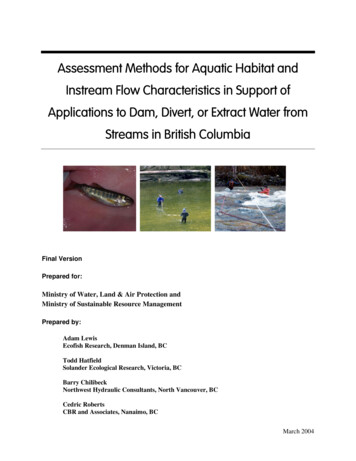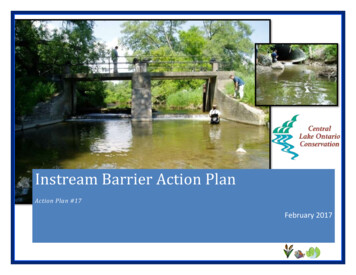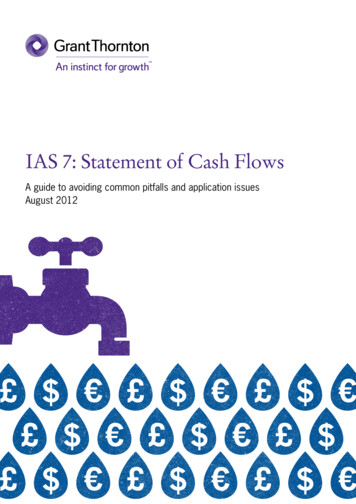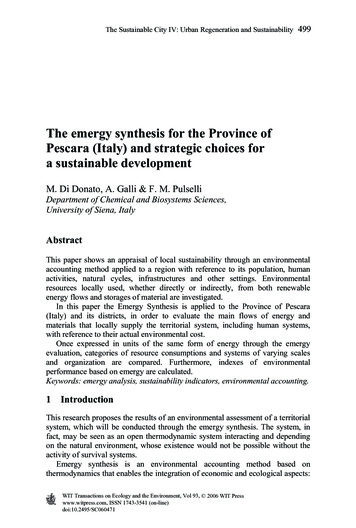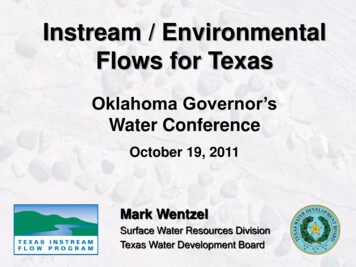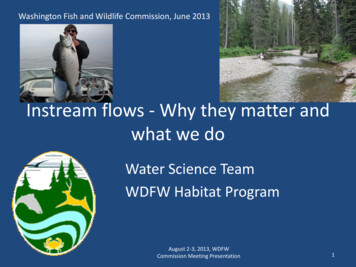
Transcription
Washington Fish and Wildlife Commission, June 2013Instream flows - Why they matter andwhat we doWater Science TeamWDFW Habitat ProgramAugust 2-3, 2013, WDFWCommission Meeting Presentation1
WDFW Water Science Team Hal BeecherSteve BoessowPaul LaRiviereJonathan KohrRobert GrangerBob VadasAugust 2-3, WDFW CommissionMeeting Presentation2
Instream Flow Instream flows are water rights for the state ,the public, and the public’s natural resources,to keep water instream.– RCW 90.22.010, 90.54.020(3)(a), 90.82.020(3)August 2-3, 2013, WDFW CommissionMeeting Presentation3
Growth of human population andeconomy increased demand for water Freshwater is a finite resource,but human demand is growing.The result will be less water in streams andless production of fish and wildlife.But, also increased demand for instream values –instream flows are for peopleAugust 2-3, 2013, WDFW CommissionMeeting Presentation4
Objective Protect and restore flowdependent stream andriparian habitat for fish andother wildlifeInstream flows through state and federalwater law forstate water allocation andmajor projects (FERC, EFSEC, CWA, etc.)Policy and draft legislation review toattempt to retain habitat protectionauthorityAugust 2-3, 2013, WDFW CommissionMeeting Presentation5
Water quantity and quality are important forall fish and wildlife (Even many marine species have indirectdependence on freshwater)August 2-3, 2013, WDFW CommissionMeeting Presentation6
Flow Impacts to FishAcute (stranding, impassable shallow riffles, redddewatering)Chronic (crowding and interspecific competition,water quality) – mediated by habitat reductionAugust 2-3, 2013, WDFW CommissionMeeting Presentation7
Flow Impacts to Fish: Washington andother Pacific coast studies since 1940s: Lower dry season flows fewer smolts fewer adult fish– strong relationship for coho salmon,detectable relationship for steelhead.- (It’s harder to detect the more complex thelife history – coho salmon have the mostconsistent life history of salmon that rear infresh water.)August 2-3, 2013, WDFW CommissionMeeting Presentation8
Fish NEEDWaterBingham Cr Coho 000Linear (Pre-1992)30,000Linear (Post-1992)20,00010,00000%50%100%150%Puget Sound Summer Low Flow Index Abundant literature relates fish growth, health, andproduction to flow and flow-related variables. Forreferences, es.htmSo do WILDLIFE and RIPARIAN habitats.August 2-3, 2013, WDFW CommissionMeeting Presentation9
Instream Flow – Legal Context Water quantity is regulated by the state(Ecology) with a few exceptions. Washingtonwater law (RCW 90.03.010) is based on theprior appropriation doctrine: water rights, once issued, are perpetualsubject to conditions; oldest (senior) has priority; but water rights can be lost if not used.August 2-3, 2013, WDFW CommissionMeeting Presentation10
Instream Flow –Legal Context Unfortunately, thismeans that somepeople have thelegal right to dry upa stream!August 2-3, 2013, WDFW CommissionMeeting Presentation11
Instream flows through state andfederal law Water right application review (RCW 77.55.050; 90.03 andassociated water laws) Assist in establishment of instream flows for watersheds(RCW 90.22, 90.54, 90.82) Establish instream flows as conditions of hydroelectriclicenses through the Federal Energy Regulatory Commissionand Clean Water Act Restore stream flow and reduce impacts of diversion andwater use (RCW 90.38, 90.42) Potential interaction with treaty rightsAugust 2-3, 2013, WDFW CommissionMeeting Presentation12
WDFW Water Science Team functions Use tools and knowledge of stream ecology, water use byhumans, and water law for:– Water right application review– Recommend instream flows to be set by rule– Recommend instream flows for hydropower and other majorprojects– Recommend, prioritize, evaluate and monitor flow restoration Improve tools to strengthen credibility of ourrecommendations– Fish-flow interaction– Fish-habitat association– Modeling Legislation review and policy review Outreach and education – it is a public policy issue affectingpublic values and affected by public opinionJune 7-8, 2013, WDFW CommissionMeeting Presentation13
Putting the tools to work The bulk of Water Science Team time is spentapplying instream flow methods:– (a) to establish instream flows and– (b) to restore flows and advocating and negotiating for instreamflows.June 7-8, 2013, WDFW CommissionMeeting Presentation14
Putting the tools to work LITIGATION and EXPERT TESTIMONY oninstream flows – water rights appeals Including 1992 U.S. Supreme Court decision(case 92-1911) allowing states to set instreamflows under federal Clean Water Act WaterQuality Certifications that take precedenceover Federal Energy Regulatory Commissionlicense conditions.August 2-3, 2013, WDFW CommissionMeeting Presentation15
Water right application review “It is the policy of this state that a flow of watersufficient to support game fish and food fishpopulations be maintained . “ecology may refuse to issue a permit if, in the opinionof the director, issuing the permit might result inlowering the flow of water in a stream below the flownecessary to adequately support food fish and gamefish populations . “The provisions of this section shall in no way affectexisting water rights.” RCW 77.57.020August 2-3, 2013, WDFW CommissionMeeting Presentation16
Setting Instream Flows throughWatershed Planning(ESHB 2514; RCW 90.82, 90.54, 90.22) Provide technical assistance towatershed planning units and Ecology Conduct & reviewstudies Provide instream flowrecommendations andadvocate for themAugust 2-3, 2013, WDFW CommissionMeeting Presentation17
Setting Instream Flows throughWatershed Planning(ESHB 2514; RCW 90.82, 90.54, 90.22) Given the critical importance of freshwater flow instreams for fish, wildlife, and many otherbeneficial uses,together with the finite nature of freshwater flow,setting instream flows (and then enforcingthem) is one of the most importantconservation tools available for long-termconservation.August 2-3, 2013, WDFW CommissionMeeting Presentation18
Setting Instream Flows throughWatershed Planning(ESHB 2514; RCW 90.82, 90.54, 90.22) On the day an instream flow is established itis the most junior water right on the stream.All previously established water rights aresenior.August 2-3, 2013, WDFW CommissionMeeting Presentation19
Setting Instream Flows throughWatershed Planning(ESHB 2514; RCW 90.82, 90.54, 90.22) As time passes, other water rights may beestablished, but they will be junior to theinstream flow. Without instream flows, theseother water rights could lead to depletion ofthe stream. Thus, the value of the instreamflow increases with time.August 2-3, 2013, WDFW CommissionMeeting Presentation20
Setting Instream Flows throughWatershed Planning(ESHB 2514; RCW 90.82, 90.54, 90.22) An instream flow may serve otherconservation values. If an instream flow isbased on a reasonable application of instreamflow methods and ecological understanding, itserves as a reference point for otherconservation efforts. These otherconservation efforts can build on the instreamflow, perhaps contributing to flow restoration.August 2-3, 2013, WDFW CommissionMeeting Presentation21
Instream Flowsfor HydropowerProjects Instream flows for bypassreaches Original mechanism: recommendations to FederalEnergy Regulatory Commission (FERC decides) US Supreme Court decision (Dosewallips-Elkhorn)allows Ecology to set instream flows as conditionsof the Water Quality Certification (401) under thefederal Clean Water ActAugust 2-3, 2013, WDFW CommissionMeeting Presentation22
Watershed management– holistic view of instream flow Are there “flow equivalents” (e.g., riparian preserves,mechanical modification of regulated channel, passagerestoration)? Human uses are here to stay – work with municipal watersuppliers to protect watershed integrity with emphasison headwaters Common goals Clear water – low sedimentation, good vegetationcondition Good quality – low levels of pollutants Stable flows – not flashy, typical of good vegetationcover Ample flows, at least to point of diversion23August 2-3, 2013, WDFW Commission Meeting Presentation
Flow management for existing projectsand addressing indirect flow impacts(e.g., impervious surfaces) Mitigation: Headwater reserves (naturalvegetation), including healthy riparian zone Maintain hydrology Geomorphological processes – channel form Cool, clean water less vulnerable to floods – goodspawning & rearing Connectivity from headwaters to estuaryAugust 2-3, 2013, WDFW CommissionMeeting Presentation24
Flow restoration Restore stream flow and reduce impacts ofdiversion and water use (RCW 90.38, 90.42) Meet requirements for Columbia Riverinstream flow in RCW 90.90 Prioritize flow restoration based on fishbenefit and opportunityAugust 2-3, 2013, WDFW CommissionMeeting Presentation25
Flow Restoration: Trust Water Rights Trust water rights are water rights whosepurpose is changed from anout-of-stream consumptive useto keeping the water in a stream.August 2-3, 2013, WDFW CommissionMeeting Presentation26
Columbia River Instream Atlasprioritizationof water forflowrestorationbased onhabitat quality,fish populationstatus, andwater supplyAugust 2-3, 2013, WDFW CommissionMeeting Presentation27
How much water must be left in astream to protect fish and otherwildlife?August 2-3, 2013, WDFW CommissionMeeting Presentation28
How much water?Steelhead SpawningWUA (Sq. Ft. of Habitat per 1,000 Ft. of Stream) Establishinginstream flows orseeking trust waterrights requiresknowing howmuch water isneeded when andwhere. This is a majorfocus of WDFW’sWater ScienceTeam.Steelhead Juvenile18000Chinook st 2-3, 2013, WDFW CommissionMeeting Presentation100200300400Streamflow in Cubic Feet per Second29
How much water?Ecological instream flows in the context ofwatershed processes Flows needed for channel form; ripariancondition; water quality; temporal, lateral,vertical, and longitudinal connectivity(including migration); phenology Natural systems involve interactions amonghydrology, geology, topography, seasonalcycles, daily cycles, tidal cycles (atestuaries), and biologyAugust 2-3, 2013, WDFW CommissionMeeting Presentation30
Models for Success Seattle Water Department Habitat ConservationPlan – Cedar River* Dungeness River* Walla Walla River Entiat River Upper Kittitas Lewis; Salmon-Washougal* featured in Instream FlowCouncil book on successesAugust 2-3, 2013, WDFW CommissionMeeting Presentation31
Water Science Team Research Improve knowledge of fish habitat as affected by flow andwater management Improve tools and models Reduce uncertainty in contentiousnegotiations Enhance WDFW credibility Improve effectiveness and ability to protect streamAugust 2-3, 2013, WDFW CommissionecosystemsMeeting Presentation32
Water Science Team ResearchDevelop and test tools biological responsecorrelations plunge pool method feeding station method discontinued tidal estuary method migration cue incorporate mesohabitat assess effect of land useand riparian conditionon IFIM / PHABSIM Improve shortcut toolsAugust 2-3, 2013, WDFW CommissionMeeting Presentation33
Review of draft legislation and policy How will it affect–fish, wildlife, and habitat?–WDFW ability to protect andrestore habitat?August 2-3, 2013, WDFW CommissionMeeting Presentation34
Outreach and education Inform constituents about instream valuesand their sensitivity to water management Inform interested parties about consequencesof options Instream flow and fish and wildlife are oftentaken for grantedAugust 2-3, 2013, WDFW CommissionMeeting Presentation35
Public Education participation in conferences, workshops,watershed planning contributed to InstreamFlows for Riverine ResourceStewardship (2004)andIntegrated Approachesto Riverine ResourceStewardship (2008)August 2-3, 2013, WDFW CommissionMeeting Presentation36
American Fisheries Society letter toPresident Obama 1/17/13 “Our [climate change] policy includes thefollowing statement: 4. Restore historic hydrologic regimes ”August 2-3, 2013, WDFW CommissionMeeting Presentation37
Protecting and restoringaquatic habitat Establishing and restoring instream flow to protectand restore aquatic habitat requires extensivediscussion and consideration of many factors, butsolid technical support based on Water ScienceTeam research improves chances of success.August 2-3, 2013, WDFW CommissionMeeting Presentation38
WDFW Habitat ScienceWashingtonDepartment ofFISH ANDWILDLIFEWater Science Team – working to protectWashington’s watersheds and stream ecosystemsAugust 2-3, 2013, WDFW CommissionMeeting Presentation39
instream flow. Without instream flows, these other water rights could lead to depletion of the stream. Thus, the value of the instream flow increases with time. Setting Instream Flows through Watershed Planning (ESHB 2514; RCW 90.82, 90.54, 90.22) August 2-3, 2013, WDFW Commission Meeting Presentation 20
